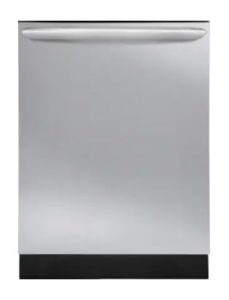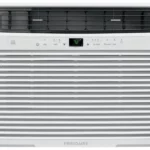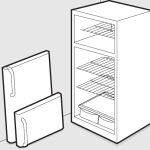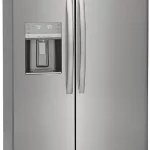Sections in this Manual
- SAFETY INSTRUCTIONS
- FGID2466QF7A PRODUCT REGISTRATION
- FEATURES AT A GLANCE
- Operating Instructions
- Child Lock Controls
- User Instruction Code
- Cycle Chart
- PREPARING AND LOADING DISHES
- FACTORS AFFECTING PERFORMANCE
- CARE AND CLEANING
- BEFORE YOU CALL
- MAJOR APPLIANCE WARRANTY
Manufactured by Frigidaire
BEFORE YOU CALL
Winterizing
A dishwasher left in an unheated place should be protected from freezing. Have a qualified person do the following:
To Disconnect Service:
- Turn off electrical power to the dishwasher at the supply source by removing fuses or tripping a circuit breaker
- Shut off the water supply
- Place a pan under the inlet valve. Disconnect the water line from the inlet valve and drain it into the pan.
- Disconnect drain line from the pump and drain water into the pan
To Restore Service:
- Reconnect the water, drain, and electrical power supply
- Turn on the water and electrical power supply
- Fill the detergent cup and run the dishwasher through a HEAVY cycle.
- Check connections to make sure they do not leak.

Property Damage Hazard
Freezing temperatures may cause water lines to rupture. Be sure all supply lines to and circulating lines within the dishwasher are protected. Failure to do so could result in property damage.

NOTE
See Installation Instructions for more details on disconnecting and restoring service to your dishwasher.
Before calling for service, review this list.
It may save you both time and expense. This list includes common experiences that are not the result of defective workmanship or material in your dishwasher.
Food Soils Left on Dishes
- Choose another cycle for a longer washing time.
- Choose the Hi-Temp Wash option.
- Check rack loading section for proper loading-avoid nesting items.
- Home water pressure may be too low – should be 20 to 120 pounds per square inch (psi).
- Check incoming water temperature. It should be at least 120oF (49oC). (See Factors Affecting Performance )
- Check water hardness. For extremely hard water, it may be necessary to install water (See Detergent Chart).
- Use Fresh Detergent.
- Make sure items are not blocking the spray arms, preventing them from rotating.
Dishes not Dry
- Select heat dry option.
- Make sure the rinse aid dispenser is filled.
- Increase the discharge setting of rinse aid. (See Rinse Aid).
- Check the incoming water temperature. Be sure it is at least 120oF (49oC).
- Check for proper loading-avoid nesting items.
- Plastic items may need to be towel dried.
- Cups with a concave bottom will collect Load them at the far left of the upper rack so they will be held in a tilted position.
Glassware/Flatware Spotted or Cloudy
- Check water hardness. For extremely hard water, it may be necessary to install water (See Detergent Chart).
- Water temperature may be low. Avoid extremely low or high temperatures. (See Factors Affecting Performance.)
- Avoid overloading and improper loading. (See Preparing and Loading Dishes).
- Use fresh detergent. Old detergent is ineffective.
- Make sure the rinse aid dispenser is filled.
- Check to see that the proper amount of detergent is being used for the cycle selected. Also, check phosphate level. (See Detergent Dispenser)
- Home water pressure may be too low – it should be 20 to 120 pounds per square inch (psi).
Dishware Chipped
- Load with care and do not overload. (See Preparing and Loading Dishes).
- Place delicate items in the top rack.
- Place glasses securely against pins and not over pins.
- Load items so they are secure and don’t jar loose when moving racks in and out. Move racks in and out slowly.
- Make sure tall glasses and stemware will clear the top of the tub when the rack is pushed in.
- Fine antique china and crystal should be hand-washed.
Water in Bottom of Tub
- Water left in the tub bottom after the cycle is complete is not normal. If water remains in the bottom of the tub, the dishwasher may not be draining properly. (See Dishwasher Does not Drain Properly).
Dishware Stained or Discolored
- Tea and coffee can stain cups. Remove the stains by hand washing in a solution of 1/2 cup (120 ml) bleach and one quart (1L) of warm Rinse thoroughly.
- Iron deposits in water can cause a yellow or brown film. A special filter installed in the water supply line will correct this problem. (See Removing Spots and Film).
- Aluminum utensils can leave gray/black marks when they rub against other items. Load Properly.
- Certain high acid foods can cause discoloration of stainless steel and plastics if allowed to sit for a long period. Use the Rinse Only cycle or rinse by hand if not operating dishwasher at once.
- Mixing stainless steel and silver utensils in silverware baskets can cause pitting of the stainless steel blades. Avoid mixing stainless steel and silver.
Cycle Takes a Long Time
- Is cycle in a water heating delay?
- Has the delay start option been selected?
- Has the sanitize option been selected?
Normal Sounds You Will Hear
- Normal sounds include water fill, water circulation and motor sounds.
Dishwasher Leaks
- Use only fresh detergent designed for automatic dishwashers. Measure detergent Try a different brand.
Etching
- Using too much detergent especially in soft or softened water causes damage that looks like a film but cannot be removed.
- Adjust the amount of detergent based on the water hardness. (Check Detergent Chart).
- Lower the water temperature.
Detergent Left in Dispenser Cup
- The detergent may be old. Discard and use fresh detergent.
- Be sure the dish load doesn’t block the spray from entering the detergent cup.
- Check to see if the cycle has been completed.
- Make sure items do not prevent the detergent dispenser from opening.
Vapor at Vent
- Spilled rinse aid can cause foam and lead to overflowing. Wipe up any spills with a damp cloth.
- Water vapor escapes from the vent during the drying part of the cycle. This is normal.
- Check to see that dishwasher is level. (See Installation Instructions).
Dishwasher Won’t Run
- Check to see if the circuit breaker is tripped or if a fuse is blown.
- Make sure the water supply is turned on.
- Check to see if the cycle is set (See Operating Instructions).
- Is the dishwasher set for the Delay Start Option?
- Make sure the door is closed and latched.
Dishwasher Won’t Fill
- Is the water supply turned on?
Dishwasher Does Not Drain Properly
- If the unit is hooked up to a food waste disposer, make sure the disposer is empty.
- Check to see if the knockout plug has been removed from inside the food waste disposer inlet.
- Check to see if the drain hose is kinked.
- Make sure the cycle is complete, not in a pause.
Dishwasher has an Odor
- Soiled dishes left in the dishwasher too long can create a Use Rinse Only cycle.
- There will be a “new” smell when first installed. This is normal.
- Check to see if the unit is draining properly. (See Dishwasher Does Not Drain Properly).
Stains on Tub Interior
- Washing large amounts of dishware with tomato-based soil can cause a pink/orange appearance. This will not affect performance and will gradually fade over time. Pre-rinsing or using the Rinse Only cycle will reduce the chance of staining. Using an air-dry option will lessen the staining.
Opening the door during cycle
- If the dishwasher door is opened while the unit is running, the START/CANCEL pad must be pressed and the door shut immediately to return the unit to the selected cycle and option.
Removing Spots and Film
Hard water can cause lime deposit buildup on the interior of the dishwasher. Dishes and glasses may also get spots and film for a number of reasons. (See Glassware/Flatware Spotted or Cloudy section). To remove buildup, and film, clean using the following instructions:
- Load clean dishes and glasses in normal Do not load any metal utensils or silverware.
- Do not add detergent.
- Select the NORMAL cycle. Press START/ CANCEL pad. Close and latch the door.
- Allow the dishwasher to run until it starts the second water fill (approximately 10 minutes).
- Unlatch and open the door and pour 2 cups of white vinegar into the bottom of the dishwasher.
- Close and latch the door and allow the cycle to finish.




